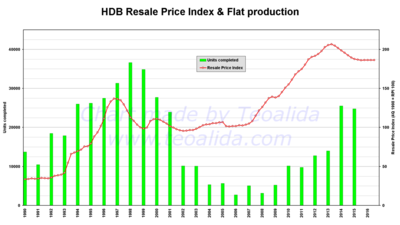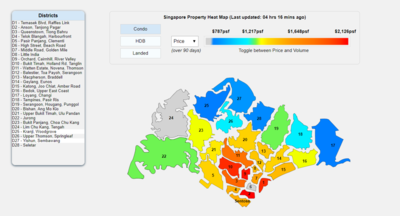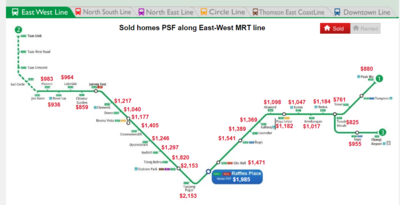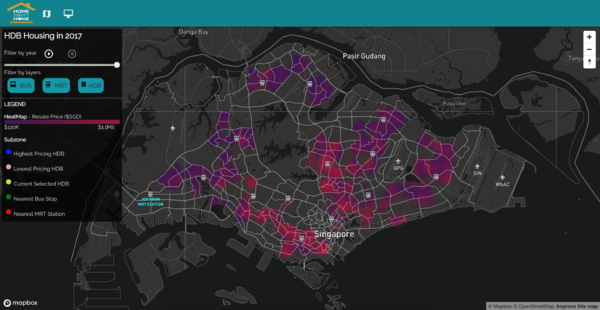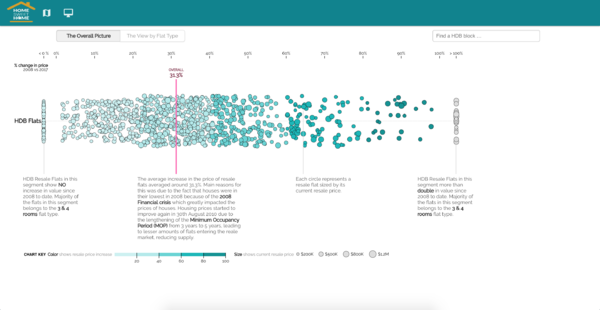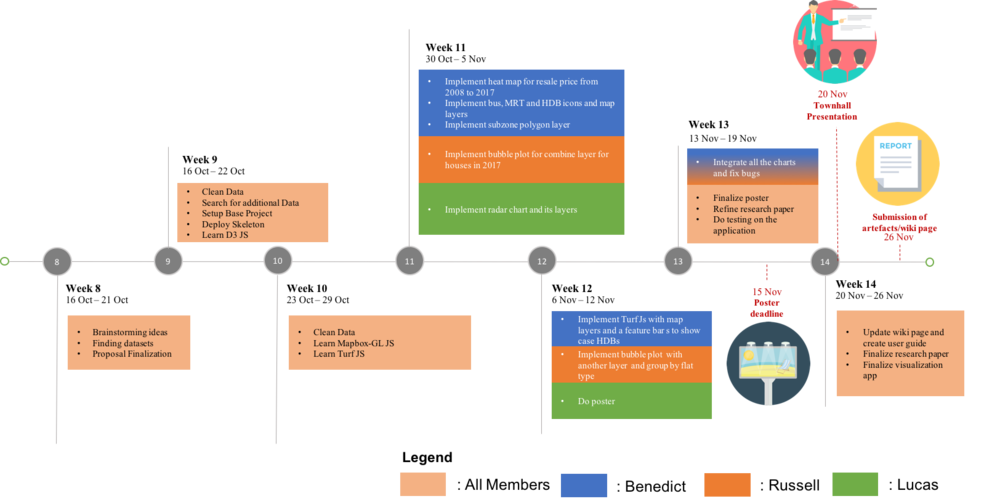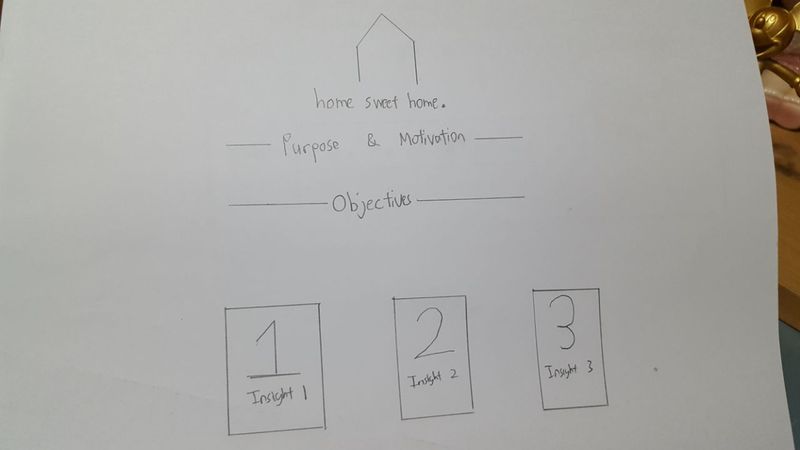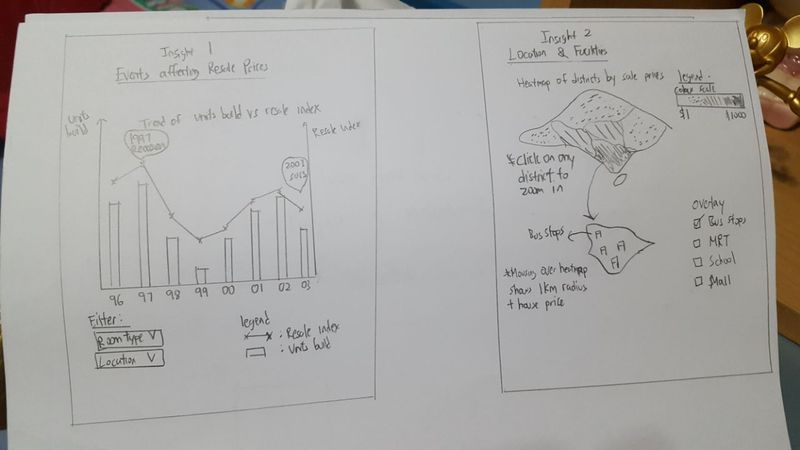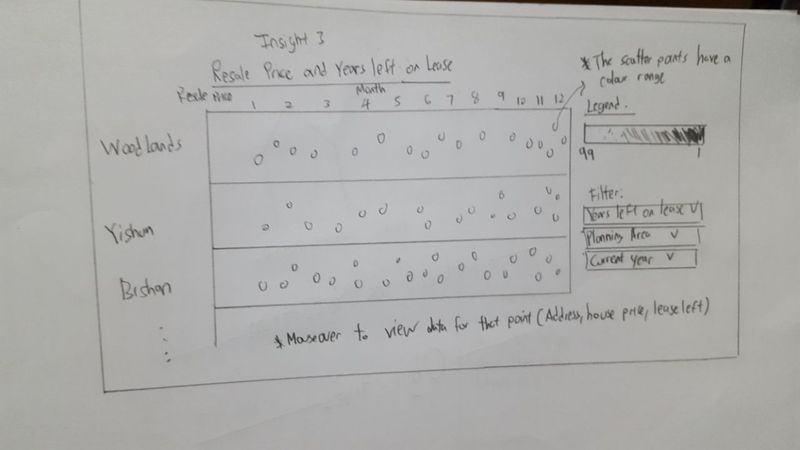Difference between revisions of "IS428 2017 18T1 Group02 Proposal"
| Line 110: | Line 110: | ||
* The colours used are striking and contrast well with each other. | * The colours used are striking and contrast well with each other. | ||
* There are dips in both variables which are not explained in the infographic itself (E.g. 1997 Asian crisis, 2003 SARs outbreak). This events could be incorporated into the charts to make it more informative. | * There are dips in both variables which are not explained in the infographic itself (E.g. 1997 Asian crisis, 2003 SARs outbreak). This events could be incorporated into the charts to make it more informative. | ||
| + | * However, major events are not shown in the chart itself. This makes it difficult for the audience to understand the various changes throughout the years. It would be much clearer if events were annotated directly on the charts. | ||
|- | |- | ||
| <p><center> '''An interactive heatmap of Singapore’s house prices in various districts''' </center></p> | | <p><center> '''An interactive heatmap of Singapore’s house prices in various districts''' </center></p> | ||
| Line 118: | Line 119: | ||
* The use of filters allows user to find out more about the price distribution of each house type easily. | * The use of filters allows user to find out more about the price distribution of each house type easily. | ||
* When user mouseover a district on the heatmap, the corresponding district on the legend is highlighted. This improves usability as users do not have to match district numbers manually. | * When user mouseover a district on the heatmap, the corresponding district on the legend is highlighted. This improves usability as users do not have to match district numbers manually. | ||
| + | * Even though the colours are intuitive, it could still be confusing as audience might still have to constantly refer back to the colour scale to interpret the colours. Colour intensity of a single colour could be used instead of to illustrate the difference in prices. | ||
|- | |- | ||
| <p><center> '''An interactive visualization of house prices along MRT stations''' </center></p> | | <p><center> '''An interactive visualization of house prices along MRT stations''' </center></p> | ||
| Line 125: | Line 127: | ||
* This visualization makes use of unique ways to illustrate the relation between nearby facilities and house prices. | * This visualization makes use of unique ways to illustrate the relation between nearby facilities and house prices. | ||
* The separating of the various MRT lines using filters at the top prevent too much information from being shown in one page | * The separating of the various MRT lines using filters at the top prevent too much information from being shown in one page | ||
| + | * However, this chart could be too high level and general. Illustrating this on the Singapore map would be more useful instead, where each house's proximity to the MRT station and their respective resale price is shown. | ||
|} | |} | ||
Revision as of 00:06, 20 November 2017
With housing prices being a hot topic that most undergraduates are talking about as we approach that final period called graduation, don't you wish that there was a way for us to get a better picture of the housing market so that we can make our big decision on where we are going to live from now on? Thus, we sought out to look for a dataset which would be able to provide us with the required information we needed to come up with useful visualizations. Unfortunately, most datasets are incomplete or not useful in providing us with any insight unless a good amount of data cleaning and wrangling is done. For example, transaction data which only gives you the block number and road name with no postal code. How is that useful? Therefore, one of our primary goals is to come up with a visualization which would provide users with useful information about the resale market in Singapore and help people gain access to a better data set than the ones currently out there. On top of that, we want to create an easy-to-use visualization tool that can help people analyze the historical flat data so that users can see which flats in Singapore would be the most value for money so that users can actually buy a home which is worth its investment. We also felt that it would be interesting to explore the patterns in the resale flat prices and see what factors really affect the prices of HDBs and find out how much of a premium people attach to amenities such as proximity to public transport, age of the lease, schools and etc...
In this project, we are interested to create a visualisation that helps users perform the following:
- View the trend in the resale prices over time with respect to major events that happened in the year (Example: 1993 Change in Pricing Model,1997 Recession
- Identify which areas are more expensive and possible reasons for the high value (Proximity to public transport, Schools, Shopping Malls, Park)
- To find out if getting a specific HDB is a good investment based on the number of year left on the lease and which locations may potentially be more profitable based on the age of the HDB.
By using our visualisation, we will be able to give users a better idea of the pricing situation of the resale HDBs so that people can make better decisions in the HDB which they want to choose to call their home. Such as when is the best time to buy as HDB; where are the most profitable / cheapest locations; whether a HDB is expensive
In our analysis, we will only be using data within the year of 1990 - 2017. The rationale for the range of data selected is as follows:
The dataset for analysis will be retrieved from multiple databases, as elaborated below:
| Dataset/Source | Data Attributes | Rationale Of Usage |
|---|---|---|
(https://data.gov.sg/dataset/resale-flat-prices?resource_id=83b2fc37-ce8c-4df4-968b-370fd818138b ) (https://data.gov.sg/dataset/resale-flat-prices?resource_id=8c00bf08-9124-479e-aeca-7cc411d884c4 ) (https://data.gov.sg/dataset/resale-flat-prices?resource_id=adbbddd3-30e2-445f-a123-29bee150a6fe ) |
|
|
(https://www.mytransport.sg/content/mytransport/home/dataMall.html#) |
|
|
(https://www.mytransport.sg/content/mytransport/home/dataMall.html#) |
|
|
(https://data.gov.sg/dataset/school-directory-and-information) |
|
|
There are many charts and visualisations available which illustrates the various trends of house prices and index. We have selected a few of these to study and learn before we begin developing our own visualizations.
| Related Works | What We Can Learn |
|---|---|
|
|
|
| |
|
| Proposed Layout | How Analyst Can Conduct Analysis |
|---|---|
| |
| |
|
The following are some of the key technical challenges that we may face throughout the course of the project:
| Key Technical Challenges | How We Propose To Resolve |
|---|---|
| |
| |
| |
|
The following shows our project timeline for the completion of this project:
The following are some of the tools/technologies that we will be utilizing during the project:
- Excel
- D3.js
- DC.js
- Turf.js
- Proj4.js
- OneMap API
- Google Search API
- Mapbox.js
- Github
- Node.js
- Angular.js
- DrWealth’s infographic (https://www.drwealth.com/singapore-property-prices-along-mrt-lines/)
- Data Gov Database (https://data.gov.sg)
- D3.js (https://d3js.org/)
- Examples By Mike Bostock (https://bost.ocks.org/mike/example/)
- Housing Development Board (http://www.hdb.gov.sg/cs/infoweb/residential/buying-a-flat/resale/resale-statistics)
The following are some of the proposed storyboard that we designed during our brainstorming sessions:
Our idea was to provide charts which are able to visualise the trends of HDB over the years in Singapore. We decided to split into multiple charts to be able to showcase the information more clearly.
Feel free to comments, suggestions and feedbacks to help us improve our project! (:

